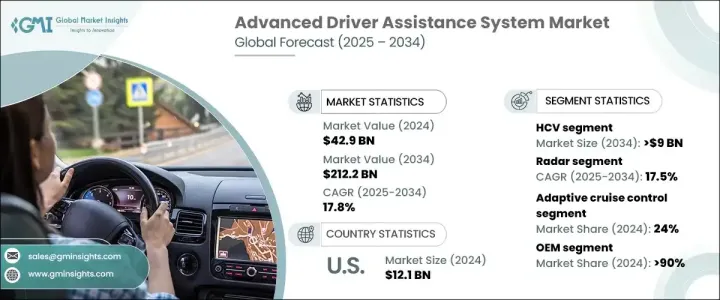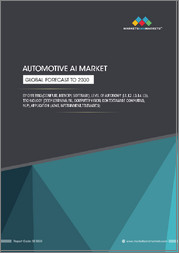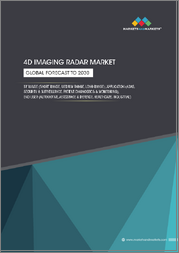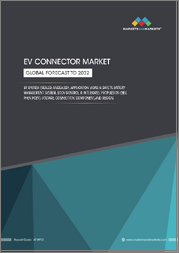
|
시장보고서
상품코드
1698555
ADAS(첨단 운전자 보조 시스템) 시장 기회, 성장 촉진 요인, 산업 동향 분석, 예측(2025-2034년)Advanced Driver Assistance System (ADAS) Market Opportunity, Growth Drivers, Industry Trend Analysis, and Forecast 2025-2034 |
||||||
세계 ADAS(첨단 운전자 보조 시스템) 시장은 2024년에 429억 달러로 평가되었으며, 2025년부터 2034년까지 연평균 복합 성장률(CAGR) 17.8%로 성장할 것으로 예측됩니다.
이 시장 확대의 원동력이 되고 있는 것은 반도체 기술의 진보에 의한 센서의 소형화, 경량화, 저가격화입니다.

안전 기능에 대한 소비자의 기대가 높아짐에 따라 제조업체는 차량의 쾌적성과 안전성을 적극적으로 개선하고 있습니다. 자동차 제조업체는 어댑티브 크루즈 컨트롤, 레인 어시스트, 자동 긴급 브레이크, 보행자 모니터 등의 선진 안전 기술을 도입하여 진화하는 사용자 수요에 대응하고 있습니다.
| 시장 범위 | |
|---|---|
| 시작 연도 | 2024년 |
| 예측 연도 | 2025-2034년 |
| 시작 금액 | 429억 달러 |
| 예측 금액 | 2,122억 달러 |
| CAGR | 17.8% |
센서 기술은 ADAS 기능에서 매우 중요한 역할을 합니다. 시장은 LiDAR, 적외선, 초음파, 레이더, 이미지 센서로 구분됩니다. 연평균 17.5%로 확대될 것으로 예측되고 있습니다. 이미지 센서는 물체 감지, 차선 일탈 경고, 교통 표지 인식을 강화합니다.
기술의 진보는 ADAS의 기능을 변화시키고 있습니다. 여러 기능으로 분류됩니다. 적응형 크루즈 컨트롤은 2024년 24%의 점유율로 시장을 독점했습니다.
자동차 제조업체는 ADAS 기능을 급속히 채용하고 있어 OEM이 유통 부문을 지배해, 2024년에는 시장의 90% 이상을 차지했습니다. 새롭게 제조되는 자동차에의 ADAS 컴퍼넌트의 조기 탑재가, 이 성장을 뒷받침하고 있습니다 안전에 대한 의식이 높아짐에 따라, OEM 각 사는 소비자 수요에 응하기 위해, 선진 운전 지원을 표준 기능 또는 옵션 기능으로서 포함하고 있습니다.
북미의 ADAS 시장은 현저한 성장을 이루고 있으며, 미국이 2024년 매출액 121억 달러로 이 지역을 리드하고 있습니다. 가속화하고 있습니다.커넥티드 드라이빙과 자율주행에 대한 주목의 고조가 시장 확대를 더욱 뒷받침하고 있어, 제조업체는 유저 체험, 안전성, 운전 효율을 높이기 위해 ADAS 기능을 최신 차종에 넣고 있습니다.
목차
제1장 조사 방법과 조사 범위
- 조사 디자인
- 조사 접근
- 데이터 수집 방법
- 기본 추정과 계산
- 기준연도의 산출
- 시장추계의 주요 동향
- 예측 모델
- 1차 조사와 검증
- 시장 범위와 정의
제2장 주요 요약
제3장 업계 인사이트
- 생태계 분석
- 부품 공급자
- 기술 제공업체
- 제조업체
- 유통 채널
- 최종 용도
- 공급자의 상황
- 이익률 분석
- 기술 혁신의 상황
- 특허 분석
- 비용 분석
- 주요 뉴스 및 이니셔티브
- 규제 상황
- 영향요인
- 성장 촉진요인
- 북미에서의 사고 방지에 관한 정부 규제의 뒷받침
- 교통안전에 관한 유럽위원회의 새로운 대처
- 전기자동차 수요 증가
- 자율주행 기술의 출현
- 업계의 잠재적 위험 및 과제
- 높은 부품 비용과 기술 비용
- 호환성에 대한 우려
- 성장 촉진요인
- 성장 가능성 분석
- Porter's Five Forces 분석
- PESTEL 분석
제4장 경쟁 구도
- 소개
- 기업 점유율 분석
- 경쟁 포지셔닝 매트릭스
- 전략 전망 매트릭스
제5장 시장 추정 및 예측 : 기술별, 2021년-2034년
- 주요 동향
- 어댑티브 크루즈 컨트롤
- 자동 하이빔 제어
- 사각 감지
- 드라이버 모니터링
- 전방 충돌 경보
- 전면 조명
- 자동 긴급 브레이크(AEB)
- 나이트 비전 시스템
- 헤드업 디스플레이
- 차선 일탈 경보 시스템
- 파크 어시스트 시스템
- 서라운드 뷰 시스템
- 교통 표지 인식 시스템
- 타이어 공압 모니터링 시스템
제6장 시장 추정 및 예측 : 센서별, 2021년-2034년
- 주요 동향
- LiDAR
- 적외선
- 초음파
- 레이더
- 이미지
제7장 시장 추정 및 예측 : 차량별, 2021년-2034년
- 주요 동향
- PCV
- LCV
- HCV
제8장 시장 추정 및 예측 : 유통 채널별, 2021년-2034년
- 주요 동향
- OEM
- 애프터마켓
제9장 시장 추정 및 예측 : 지역별, 2021년-2034년
- 북미
- 미국
- 캐나다
- 유럽
- 영국
- 독일
- 프랑스
- 이탈리아
- 스페인
- 러시아
- 북유럽
- 아시아태평양
- 중국
- 인도
- 일본
- 한국
- 태국
- 인도네시아
- ANZ
- 싱가포르
- 라틴아메리카
- 브라질
- 멕시코
- 아르헨티나
- 중동 및 아프리카
- UAE
- 사우디아라비아
- 남아프리카
- 이란
- 튀르키예
제10장 기업 프로파일
- Arisin
- Autoliv
- Bosch
- Continental
- Delphi
- Denso
- Gentex
- Harman International(Samsung)
- Hyundai Mobis
- Hella
- Ningbo Joyson Electronic
- Magna
- Mobileye
- NVIDIA
- NXP
- Panasonic
- Renesas Electronics
- Texas
- Valeo
- ZF Friedrichshafen
The Global Advanced Driver Assistance System Market, valued at USD 42.9 billion in 2024, is projected to grow at a CAGR of 17.8% from 2025 to 2034. The expansion is driven by advancements in semiconductor technology, which have led to smaller, lighter, and more affordable sensors. This progress is reducing system complexity, thus making ADAS features more accessible to a broader audience. The rise of electric vehicles (EVs) has also intensified the demand for enhanced safety integrations, pushing automotive manufacturers to refine their systems.

As consumer expectations for safety features rise, manufacturers are actively improving vehicle comfort and security. The passenger commercial vehicle (PCV) segment led the ADAS market with over 60% share in 2024, while the heavy commercial vehicle (HCV) segment is forecasted to surpass USD 9 billion by 2034. Automakers are incorporating advanced safety technologies, including adaptive cruise control, lane assist, automatic emergency braking, and pedestrian monitoring, catering to evolving user demands. The increasing emphasis on driver safety is encouraging the adoption of ADAS across both passenger and heavy-duty vehicles.
| Market Scope | |
|---|---|
| Start Year | 2024 |
| Forecast Year | 2025-2034 |
| Start Value | $42.9 Billion |
| Forecast Value | $212.2 Billion |
| CAGR | 17.8% |
Sensor technology plays a pivotal role in ADAS functionality. The market is segmented into LiDAR, infrared, ultrasonic, radar, and image sensors. Image sensors accounted for approximately 34.9% of the market share in 2024, while the radar segment is projected to expand at a CAGR of 17.5% by 2034. Image sensors enhance object detection, lane departure alerts, and traffic sign recognition. To address low-light conditions and improve power efficiency, manufacturers are introducing next-generation image sensors, ensuring improved functionality in varying driving environments.
Technological advancements are transforming ADAS capabilities. The market is categorized into multiple features, including adaptive cruise control, blind spot detection, automatic high beam control, driver monitoring, forward collision warning, night vision, lane departure warning, park assistance, and tire pressure monitoring. Adaptive cruise control dominated the market with a 24% share in 2024. The integration of artificial intelligence and machine learning is refining vehicle response mechanisms, enhancing cruise control precision, and minimizing unnecessary alerts.
Automotive manufacturers are rapidly adopting ADAS features, with original equipment manufacturers (OEMs) dominating the distribution segment, holding over 90% of the market in 2024. The early incorporation of ADAS components into newly manufactured vehicles is fueling this growth. As safety awareness rises, OEMs are integrating advanced driving assistance as either standard or optional features to cater to consumer demand. Innovations in calibration technology are also making ADAS more cost-effective and widely available.
North America ADAS market is witnessing significant growth, with the United States leading the region with USD 12.1 billion in revenue in 2024. Stricter safety regulations, technological advancements, and increasing consumer preference for automated safety features are accelerating adoption rates. The growing focus on connected and automated driving is further propelling market expansion, with manufacturers embedding ADAS functionalities into their latest vehicle models to enhance user experience, safety, and driving efficiency.
Table of Contents
Chapter 1 Methodology & Scope
- 1.1 Research design
- 1.1.1 Research approach
- 1.1.2 Data collection methods
- 1.2 Base estimates & calculations
- 1.2.1 Base year calculation
- 1.2.2 Key trends for market estimation
- 1.3 Forecast model
- 1.4 Primary research and validation
- 1.4.1 Primary sources
- 1.4.2 Data mining sources
- 1.5 Market scope & definition
Chapter 2 Executive Summary
- 2.1 Industry synopsis, 2021 - 2034
Chapter 3 Industry Insights
- 3.1 Industry ecosystem analysis
- 3.1.1 Component suppliers
- 3.1.2 Technology provider
- 3.1.3 Manufacturers
- 3.1.4 Distribution channel
- 3.1.5 End use
- 3.2 Supplier landscape
- 3.3 Profit margin analysis
- 3.4 Technology & innovation landscape
- 3.5 Patent analysis
- 3.6 Cost analysis
- 3.7 Key news & initiatives
- 3.8 Regulatory landscape
- 3.9 Impact forces
- 3.9.1 Growth drivers
- 3.9.1.1 Supportive government regulations on accident prevention in north america
- 3.9.1.2 Emerging european commission initiatives for road safety
- 3.9.1.3 Rising demand for electric vehicles
- 3.9.1.4 Emergence of autonomous technology
- 3.9.2 Industry pitfalls & challenges
- 3.9.2.1 High component and technology costs
- 3.9.2.2 Compatibility concerns
- 3.9.1 Growth drivers
- 3.10 Growth potential analysis
- 3.11 Porter's analysis
- 3.12 PESTEL analysis
Chapter 4 Competitive Landscape, 2024
- 4.1 Introduction
- 4.2 Company market share analysis
- 4.3 Competitive positioning matrix
- 4.4 Strategic outlook matrix
Chapter 5 Market Estimates & Forecast, By Technology, 2021 - 2034 ($Bn)
- 5.1 Key trends
- 5.2 Adaptive cruise control
- 5.3 Automatic high beam control
- 5.4 Blind spot detection
- 5.5 Driver monitoring
- 5.6 Forward collision warning
- 5.7 Front lighting
- 5.8 Automatic Emergency Braking (AEB)
- 5.9 Night vision system
- 5.10 Head-up display
- 5.11 Lane departure warning system
- 5.12 Park assist system
- 5.13 Surround-view system
- 5.14 Traffic sign recognition
- 5.15 Tire pressure monitoring system
Chapter 6 Market Estimates & Forecast, By Sensor, 2021 - 2034 ($Bn)
- 6.1 Key trends
- 6.2 LiDAR
- 6.3 Infrared
- 6.4 Ultrasonic
- 6.5 Radar
- 6.6 Image
Chapter 7 Market Estimates & Forecast, By Vehicle, 2021 - 2034 ($Bn, Unit)
- 7.1 Key trends
- 7.2 PCV
- 7.3 LCV
- 7.4 HCV
Chapter 8 Market Estimates & Forecast, By Distribution Channel, 2021 - 2034 ($Bn, Unit)
- 8.1 Key trends
- 8.2 OEM
- 8.3 Aftermarket
Chapter 9 Market Estimates & Forecast, By Region, 2021 - 2034 ($Bn)
- 9.1 North America
- 9.1.1 U.S.
- 9.1.2 Canada
- 9.2 Europe
- 9.2.1 UK
- 9.2.2 Germany
- 9.2.3 France
- 9.2.4 Italy
- 9.2.5 Spain
- 9.2.6 Russia
- 9.2.7 Nordics
- 9.3 Asia Pacific
- 9.3.1 China
- 9.3.2 India
- 9.3.3 Japan
- 9.3.4 South Korea
- 9.3.5 Thailand
- 9.3.6 Indonesia
- 9.3.7 ANZ
- 9.3.8 Singapore
- 9.4 Latin America
- 9.4.1 Brazil
- 9.4.2 Mexico
- 9.4.3 Argentina
- 9.5 MEA
- 9.5.1 UAE
- 9.5.2 Saudi Arabia
- 9.5.3 South Africa
- 9.5.4 Iran
- 9.5.5 Turkey
Chapter 10 Company Profiles
- 10.1 Arisin
- 10.2 Autoliv
- 10.3 Bosch
- 10.4 Continental
- 10.5 Delphi
- 10.6 Denso
- 10.7 Gentex
- 10.8 Harman International (Samsung)
- 10.9 Hyundai Mobis
- 10.10 Hella
- 10.11 Ningbo Joyson Electronic
- 10.12 Magna
- 10.13 Mobileye
- 10.14 NVIDIA
- 10.15 NXP
- 10.16 Panasonic
- 10.17 Renesas Electronics
- 10.18 Texas
- 10.19 Valeo
- 10.20 ZF Friedrichshafen



















